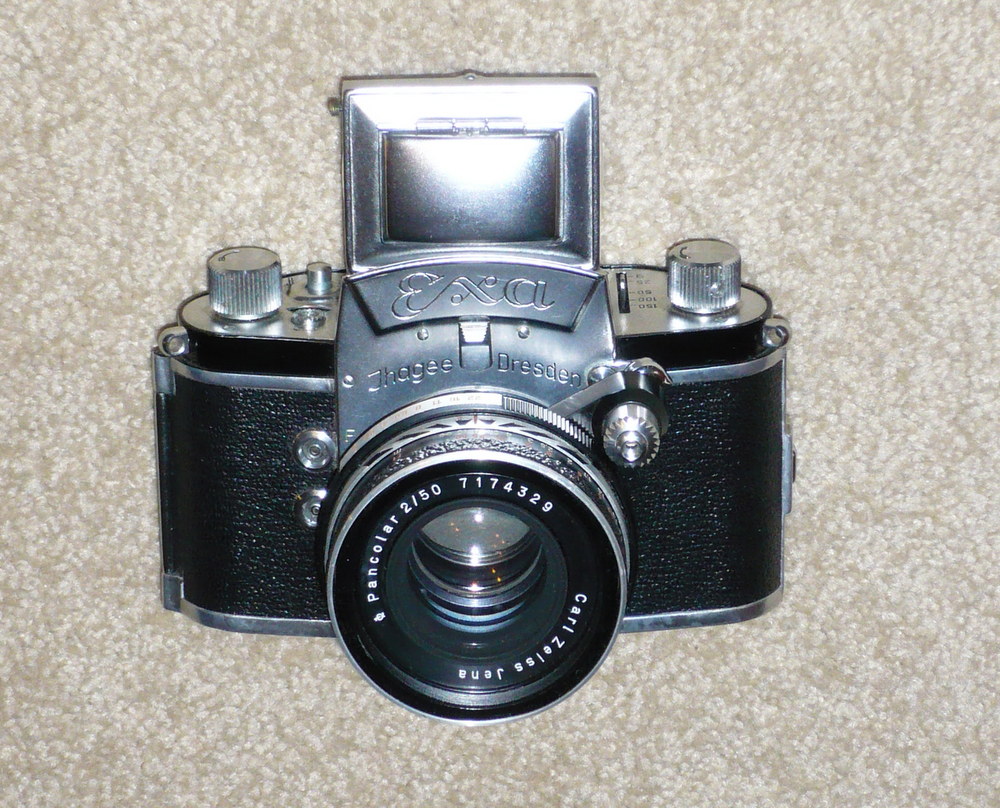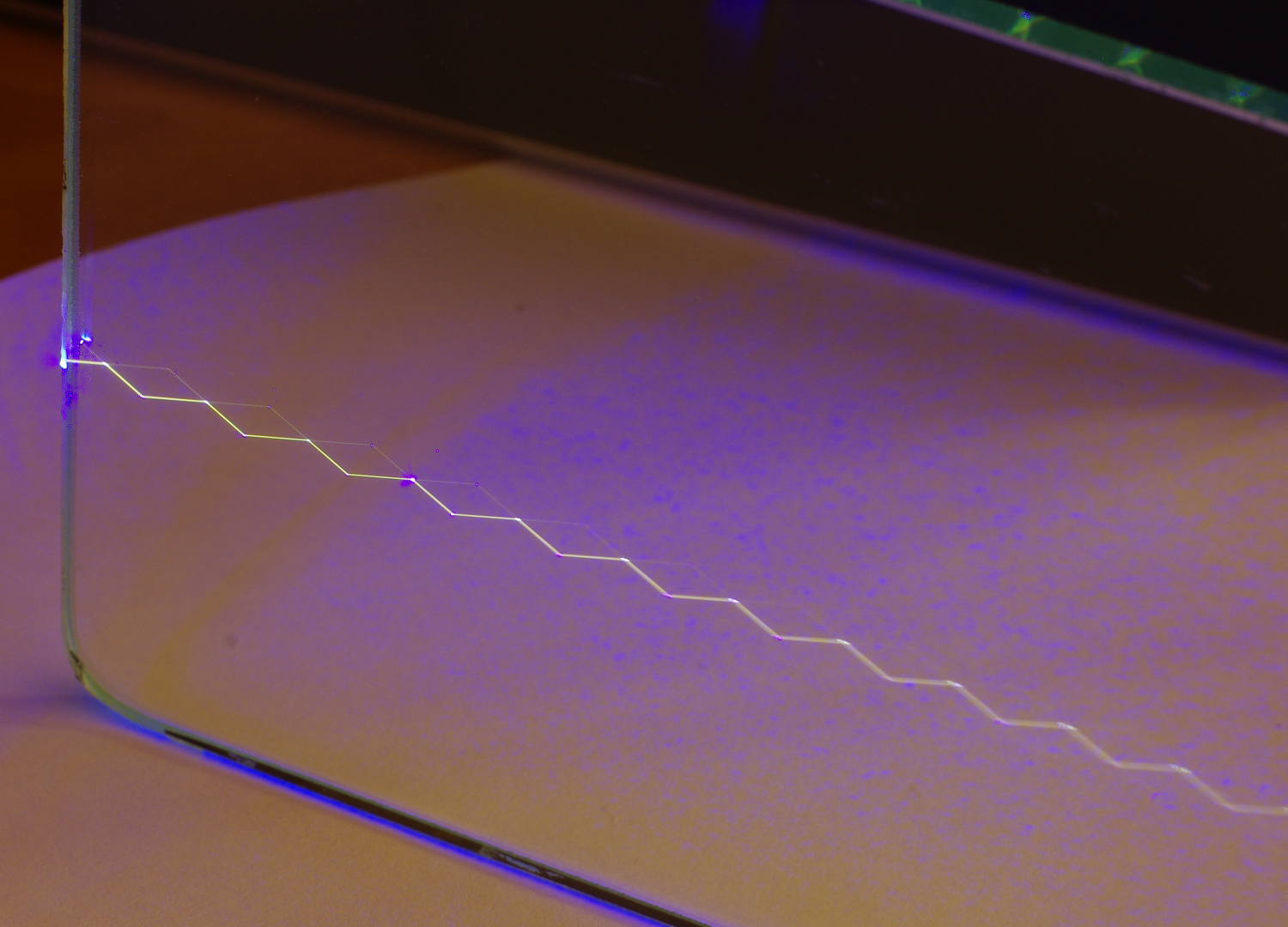|
Pentaprism
A pentaprism is a five-sided reflecting prism used to deviate a beam of light by a constant 90°, even if the entry beam is not at 90° to the prism. The beam reflects inside the prism ''twice'', allowing the transmission of an image through a right angle without inverting it (that is, without changing the image's handedness) as an ordinary right-angle prism or mirror would. The reflections inside the prism are not caused by total internal reflection, since the beams are incident at an angle less than the critical angle (the minimum angle for total internal reflection). Instead, the two faces are coated to provide mirror surfaces. The two opposite transmitting faces are often coated with an antireflection coating to reduce spurious reflections. The fifth face of the prism is not used optically but truncates what would otherwise be an awkward angle joining the two mirrored faces. In cameras A variant of this prism is the roof pentaprism which is commonly used in the viewfind ... [...More Info...] [...Related Items...] OR: [Wikipedia] [Google] [Baidu] |
Single-lens Reflex Camera
A single-lens reflex camera (SLR) is a camera that typically uses a mirror and prism system (hence "reflex" from the mirror's reflection) that permits the photographer to view through the lens and see exactly what will be captured. With twin lens reflex and rangefinder cameras, the viewed image could be significantly different from the final image. When the shutter button is pressed on most SLRs, the mirror flips out of the light path, allowing light to pass through to the light receptor and the image to be captured. History File:Hasselblad 1600F.jpg, Medium format SLR by Hasselblad (Model 1600F), Sweden File:Zenza BRONICA S2 with ZENZANON 100mm F2.8.JPG, Medium format SLR by Bronica (Model S2), Japan. Bronica's later model—the Bronica EC—was the first medium format SLR camera to use an electrically operated focal-plane shutter File:Asahiflex600.jpg, The 1952 ( Pentax) Asahiflex, Japan's first single-lens reflex camera. File:Contaflex BW 2.JPG, The Contaflex III ... [...More Info...] [...Related Items...] OR: [Wikipedia] [Google] [Baidu] |
Roof Prism
A roof prism, also called a Dachkanten prism or Dach prism (from German: ''Dachkante'', lit. "roof edge"), is a reflective prism containing a section where two faces meet at a 90° angle, resembling the roof of a building and thus the name. Reflection from the two 90° faces returns an image that is flipped laterally across the axis where the faces meet. Characteristic for a roof prism is that the beam is split in half, with one half of the beam hitting first one face then the other face, while it is invert for the other half of the beam. Therefore, a roof prism can be used only with some distance to focal planes, or the "edge" of the roof would introduce slight distortions. Furthermore, the angle between the two faces has to be very close to 90°, or image quality would be degraded. The simplest roof prism is the Amici roof prism, with other common roof prism designs being the Abbe–Koenig prism, the Schmidt–Pechan prism and probably the best known being the roof pentap ... [...More Info...] [...Related Items...] OR: [Wikipedia] [Google] [Baidu] |
Contax
Contax (stylised as CONTAX in the Kyocera era) began as a German camera model in the Zeiss Ikon line in 1932, and later became a brand name. The early cameras were among the finest in the world, typically featuring high quality Zeiss interchangeable lenses. The final products under the Contax name were a line of 35 mm, medium format, and digital cameras engineered and manufactured by Japanese multinational Kyocera, and featuring modern Zeiss optics. In 2005, Kyocera announced that it would no longer produce Contax cameras. The rights to the brand are currently part of Carl Zeiss AG, but no Contax cameras are currently in production, and the brand is considered dormant. Historical overview While the firm of Ernst Leitz of Wetzlar established the 24 mm × 36 mm negative format on perforated 35 mm movie film as a viable photographic system, Zeiss Ikon of Dresden decided to produce a competitor designed to be superior in every way. The name Contax was ch ... [...More Info...] [...Related Items...] OR: [Wikipedia] [Google] [Baidu] |
Digital Single-lens Reflex Camera
A digital single-lens reflex camera (digital SLR or DSLR) is a digital camera that combines the optics and the mechanisms of a single-lens reflex camera with a digital imaging sensor. The reflex design scheme is the primary difference between a DSLR and other digital cameras. In the reflex design, light travels through the lens and then to a mirror that alternates to send the image to either a prism, which shows the image in the viewfinder, or the image sensor when the shutter release button is pressed. The viewfinder of a DSLR presents an image that will not differ substantially from what is captured by the camera's sensor as it presents it as a direct optical view through the main camera lens, rather than showing an image through a separate secondary lens. DSLRs largely replaced film-based SLRs during the 2000s. Major camera manufacturers began to transition their product lines away from DSLR cameras to mirrorless interchangeable-lens cameras (MILC) beginning in the 2010s ... [...More Info...] [...Related Items...] OR: [Wikipedia] [Google] [Baidu] |
Pentamirror
A pentamirror is an optical device used in the viewfinder systems of various single-lens reflex cameras instead of the pentaprism. It is used to reverse again the laterally reversed image coming from the reflex mirror. Instead of the solid block of glass of the prism in pentaprism system, here 3 mirrors are used to perform the same task. This is cheaper and lighter, but generally produces a viewfinder image of lower quality and brightness. This optical device is often (more precisely) referred to as ''roof pentamirror'' because of the roof-like ridge.Paul R. Yoder. ''Opto-Mechanical Systems Design'', 2005page 435 See also *Pentaprism *Single-lens reflex camera A single-lens reflex camera (SLR) is a camera that typically uses a mirror and prism system (hence "reflex" from the mirror's reflection) that permits the photographer to view through the lens and see exactly what will be captured. With twin l ... Notes External linksUnderstanding Viewfinders [...More Info...] [...Related Items...] OR: [Wikipedia] [Google] [Baidu] |
Nikon F
The Nikon F camera, introduced in April 1959, was Nikon's first SLR camera. It was one of the most advanced cameras of its day. Although many of the concepts had already been introduced elsewhere, it was revolutionary in that it was the first to combine them all in one camera. It was produced until October 1973 and was replaced by the Nikon F2. Aspects of its design remain in all of Nikon's subsequent SLR cameras, through the current Nikon F6 film and Nikon D6 digital models (which still share its Nikon F-mount for lenses). The "F" in Nikon F was selected from the term "re-f-lex", since the pronunciation of the first letter "R" is not available in many Asian languages. That tradition was carried all the way through their top line of Nikon cameras until the introduction of the Nikon D1 (digital) cameras decades later. Specially modified Nikon F cameras were used in space in the early 1970s aboard the Skylab space station. History The Nikon F was the first 35 mm SLR sys ... [...More Info...] [...Related Items...] OR: [Wikipedia] [Google] [Baidu] |
Total Internal Reflection
Total internal reflection (TIR) is the optical phenomenon in which waves arriving at the interface (boundary) from one medium to another (e.g., from water to air) are not refracted into the second ("external") medium, but completely reflected back into the first ("internal") medium. It occurs when the second medium has a higher wave speed (i.e., lower refractive index) than the first, and the waves are incident at a sufficiently oblique angle on the interface. For example, the water-to-air surface in a typical fish tank, when viewed obliquely from below, reflects the underwater scene like a mirror with no loss of brightness (Fig.1). TIR occurs not only with electromagnetic waves such as light and microwaves, but also with other types of waves, including sound and water waves. If the waves are capable of forming a narrow beam (Fig.2), the reflection tends to be described in terms of " rays" rather than waves; in a medium whose properties are independent of direction, such as ... [...More Info...] [...Related Items...] OR: [Wikipedia] [Google] [Baidu] |
Camera
A camera is an optical instrument that can capture an image. Most cameras can capture 2D images, with some more advanced models being able to capture 3D images. At a basic level, most cameras consist of sealed boxes (the camera body), with a small hole (the aperture) that allows light to pass through in order to capture an image on a light-sensitive surface (usually a digital sensor or photographic film). Cameras have various mechanisms to control how the light falls onto the light-sensitive surface. Lenses focus the light entering the camera, and the aperture can be narrowed or widened. A shutter mechanism determines the amount of time the photosensitive surface is exposed to the light. The still image camera is the main instrument in the art of photography. Captured images may be reproduced later as part of the process of photography, digital imaging, or photographic printing. Similar artistic fields in the moving-image camera domain are film, videography, and cinematograph ... [...More Info...] [...Related Items...] OR: [Wikipedia] [Google] [Baidu] |
Reflex Camera
{{Unreferenced, date=July 2021 A reflex camera is a camera that permits the photographer to view the image that will be seen through the lens, and therefore to see exactly what will be captured, contrary to viewfinder cameras where the image could be significantly different from what will be captured. Variations A single-lens reflex camera typically uses a mirror and prism system (hence "reflex", from the mirror's reflection) to accomplish this. The mirrorless interchangeable-lens camera achieves the same result by providing the photographer with a digitally captured image. The twin-lens reflex camera provides both a viewfinder image by reflecting the image onto ground glass and an image through another lens to the film. The image exposing the film is not reflected. See also *single-lens reflex camera A single-lens reflex camera (SLR) is a camera that typically uses a mirror and prism system (hence "reflex" from the mirror's reflection) that permits the photographer to view ... [...More Info...] [...Related Items...] OR: [Wikipedia] [Google] [Baidu] |
Critical Angle (optics)
Total internal reflection (TIR) is the optical phenomenon in which waves arriving at the interface (boundary) from one medium to another (e.g., from water to air) are not refracted into the second ("external") medium, but completely reflected back into the first ("internal") medium. It occurs when the second medium has a higher wave speed (i.e., lower refractive index) than the first, and the waves are incident at a sufficiently oblique angle on the interface. For example, the water-to-air surface in a typical fish tank, when viewed obliquely from below, reflects the underwater scene like a mirror with no loss of brightness (Fig.1). TIR occurs not only with electromagnetic waves such as light and microwaves, but also with other types of waves, including sound and water waves. If the waves are capable of forming a narrow beam (Fig.2), the reflection tends to be described in terms of " rays" rather than waves; in a medium whose properties are independent of direction, such as air, ... [...More Info...] [...Related Items...] OR: [Wikipedia] [Google] [Baidu] |
Prism (optics)
An optical prism is a transparent optical element with flat, polished surfaces that are designed to refract light. At least one surface must be angled — elements with two parallel surfaces are ''not'' prisms. The most familiar type of optical prism is the triangular prism, which has a triangular base and rectangular sides. Not all optical prisms are geometric prisms, and not all geometric prisms would count as an optical prism. Prisms can be made from any material that is transparent to the wavelengths for which they are designed. Typical materials include glass, acrylic and fluorite. A dispersive prism can be used to break white light up into its constituent spectral colors (the colors of the rainbow) as described in the following section. Other types of prisms noted below can be used to reflect light, or to split light into components with different polarizations. Types Dispersive ''Dispersive prisms'' are used to break up light into its constituent spectral col ... [...More Info...] [...Related Items...] OR: [Wikipedia] [Google] [Baidu] |





